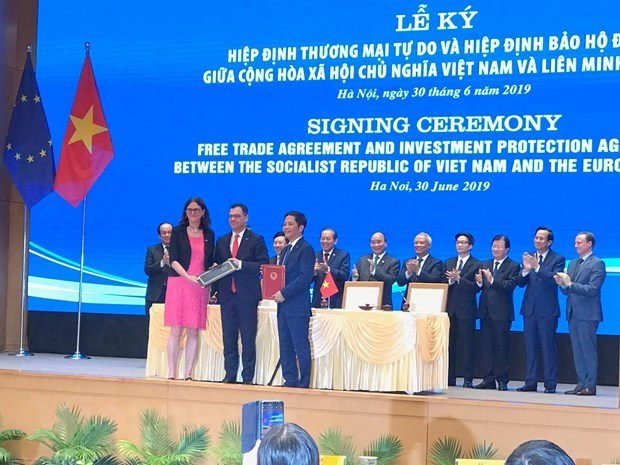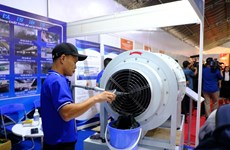Vietnam's economy after 13 years of WTO membership
After 13 years of joining the World Trade Organisation (WTO), Vietnam has become a part of the global economy with total export and import turnover of nearly 480 billion USD, nearly double its GDP.
 Producing textiles and garments for export. (Photo: VNA)
Producing textiles and garments for export. (Photo: VNA)Hanoi (VNA) – After 13 years of joining the World Trade Organisation (WTO) (November 7, 2006-2019), Vietnam has become a part of the global economy with total export and import turnover of nearly 480 billion USD, nearly double its gross domestic product (GDP).
Vietnam's economy is integrating deeply into the region and the world. The opening of the economy has become an important driving force for economic growth, contributing significantly to maintaining the high annual growth rate of the Vietnamese economy.
The past over 10 years witnessed many global crises which have significantly impacted on Vietnam's economy as well as its international integration.
However, with internal reforms and economic-trade and investment multilateralisation and diversification policies with more than 200 countries and territories, Vietnam has achieved many important results that are meaningful for strongly promoting its economic growth and international integration.
When joining WTO in 2006, the country's economic scale was still modest and Vietnam was in the group of low-income countries. In 2016, when joining the ASEAN Economic Community (AEC) and new free trade agreements (FTAs), Vietnam entered the group of low middle-income countries and was one of 32 countries with export turnover of over 100 billion USD. It also attracted the most stable FDI volume in ASEAN.
As of October 2019, Vietnam lure 30,136 FDI projects with a total registered capital of 358.53 billion USD.
Many leading economic groups in the world have chosen Vietnam as their "destination," including Intel, Microsoft, Samsung, LG, Nokia, Canon, Mitsubishi, Toyota and Honda.
Despite being affected by the global financial and public debt crises, Vietnam's economy has still maintained an average growth rate of nearly 7 percent per year, reaching 7.08 percent in 2018 - the highest increase in a decade.
The income per capita has also improved significantly, increasing from 730 USD in 2006 to 2,587 USD in 2018.
The economic structure has shifted in a positive direction, gradually increasing the proportion of industry and services.
The strong development of international trade has helped to increase the country’s export and import turnover, expanding markets and diversifying import and export goods.
Vietnam has become a part of the global economy with total export and import turnover of nearly 480 billion USD, nearly double its gross domestic product (GDP).
From a country that frequently posted trade deficit, Vietnam has balanced import and export, and even enjoyed trade surplus.
As a member of the WTO, Vietnam has been recognized by more than 70 partners as a market economy, with many products gradually gaining a foothold and becoming competitive in demanding markets such as the European Union, Japan and the US.
Not only having a strong and positive impact on the socio-economic development of Vietnam, economists said that the WTO membership is a "big door" for the country to step into the "global playground”.
Joining the WTO, Vietnam has gradually opened its goods and services market under multilateral and bilateral agreements.
 The signing ceremony of the EU-Vietnam Free Trade Agreement and Investment Protection Agreement in Hanoi (Photo: VietnamPlus)
The signing ceremony of the EU-Vietnam Free Trade Agreement and Investment Protection Agreement in Hanoi (Photo: VietnamPlus)The negotiation, signing and implementation of FTAs, especially the new-generation ones and the chairing of major multilateral conferences in recent years have helped Vietnam both ensure national interests and significantly enhance its international capacity and position.
Up to now, Vietnam has already signed and been negotiating 17 bilateral and multilateral FTAs. Among them, 12 have entered into force and are being implemented. With the negotiation and signing of a series of FTAs, especially the new generation ones such as the EU-Vietnam FTA, the Trans-Atlantic Investment and Trade Partnership (TITP), the Comprehensive and Progressive Agreement for Trans-Pacific Partnership (CPTPP), the ASEAN + 1 FTA, and the Australia-US FTA).
However, according to experts, despite being named in the fastest growing economies in the world, Vietnam's economy has not yet developed as expected.
In industry, the mining and processing sector still accounts for a large proportion while the use of advanced technology and products with high content of technology and intelligence remains limited.
Despite many achievements in agriculture, the proportion of processed agricultural products is low, and the application of science and technology in agricultural production remains slow. There are many shortcomings in the supply chain of agricultural products.
 Prime Minister Nguyen Xuan Phuc (eighth, right) and leaders of other countries attend the 3rd Regional Comprehensive Economic Partnership (RCEP) Summit (Photo: VNA)
Prime Minister Nguyen Xuan Phuc (eighth, right) and leaders of other countries attend the 3rd Regional Comprehensive Economic Partnership (RCEP) Summit (Photo: VNA)To continue sustainable development, experts said that Vietnam needs breakthrough reforms and reform the state administrative apparatus. It should restructure businesses and infrastructure services towards focusing on services with potential and advantages and developing green logistics.
In particular, the country should increase investment in science and technology to soon have breakthroughs in the field, creating high-tech goods and products that bring in high export value.
Along with the great achievements of historical significance after the renewal process, the WTO membership has enhanced Vietnam’s position in the international arena, facilitating the effective implementation of its foreign policy of independence, self-reliance, diversification and multilateralisation.
In the context of complicated world situation, the resolution of a series of challenges is the key for Vietnam to continue bringing its economy to the big sea./.













